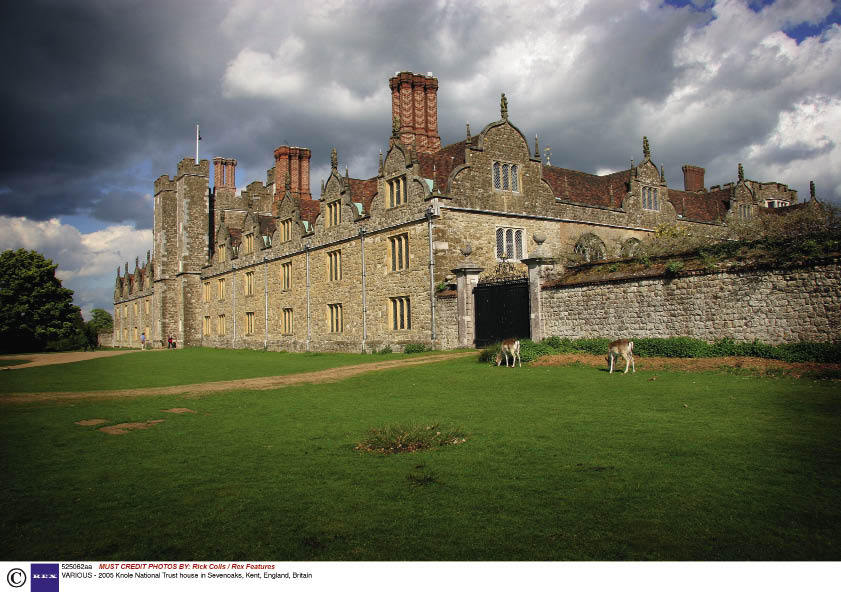Knole is a country house the size of a small village in the Kent countryside. For the past 400 years it has been inhabited by 13 generations of a single family, the Sackvilles. The present Lord Sackville, Robert Sackville-West who lives with his family there, has written a scholarly book on Knole’s effect on the family and vice versa.
It was Thomas Sackville who in the 1590s transformed a late medieval manor house into the Renaissance mansion that has become today’s tourist attraction. Like the Cecils, who were his colleagues in government, he made little distinction between enriching the crown and his own family, just as today’s MPs fiddled expenses to feather their own nests. As a loyal servant of Elizabeth and James I, he became one of the richest landowners in England. Yet Knole, the pride of Thomas Sackville, conferring prestige in a status-based society, cannot quite match the magnificence of Blenheim or Hatfield. Although several members of the family occupied great offices of state, the Sackvilles never became as powerful as the Cecils or Churchills.
The prosperity, indeed the continued existence, of such great estates depended on the family’s production of suitable heirs. Thomas’s lands passed to Richard Sackville, a hopelessly lavish gambler. In 16 years he spent what his forefathers had taken a century to acquire, leaving debts the equivalent today of six million pounds. He tried to get hold of his wife Lady Anne Clifford’s inheritance with the help of James I and his Archbishop of Canterbury, but she defied them all. Scarcely surprisingly, their marriage broke down and she recorded her sufferings in her diary. Patterns repeat themselves. Two centuries later, Victoria, the wife of Lionel, initially found her husband ‘a dream in bed’; but family quarrels wore down her once colourful personality. Her husband found solace in his mistresses.
Vita Sackville-West dismissed her ancestors as ‘stark staring mad’; they ranged from eccentrics pottering about the park in shabby clothes caring for the trees, to grandees, entertaining the royal family as well as Mrs Simpson; from patrons of the arts to philistines who found the upkeep of the great house a tiresome burden.
John Frederick Sackville, ambassador to France in the 1780s, was a fanatical cricketer, and his team, composed of servants and tenants, attracted crowds of thousands. ‘If the French noblesse had been capable of playing cricket with their peasants’, the historian G. M. Trevelyan wrote, ‘their châteaux would never have been burnt’, and the French Revolution might never have happened.
In the 1870s the inhabitants of Knole’s neighbouring town of Sevenoaks as well as trippers from London took to invading the park for picnics. Iron gates were built to keep them out. The locals mutinied and as Lord Lieutenant of Kent, Lionel was able to call on 200 policemen to restore order.
By the 1930s the most familiar Sackville to the literate public was Vita. Brought up at Knole, she loved it more than anything else in life, but as a woman she could not inherit it. She became an aristocratic blue-stocking and a poet of distinction. Married to Harold Nicolson, she refused to let him, as a commoner, be buried in the family vault.
Inheritance is not only a family history. It is a contribution to the history of the English aristocracy. In the 1920s, with one country house a week being demolished or turned into an institution, it looked as if the aristocracy were on the way out. Tipping the housekeeper, as in the days of Jane Austen, my father took me, in 1924, to visit Longleat, the mansion of the Bath family. It was in a sorry state, with straggling hedges and unmown lawns.
Later the tide began to turn, and some families saw the commercial possibilities of their estates, not least the Baths. The Sackvilles, however, were not so minded, and after long negotiations the financial burden of maintaining the great house was finally handed over to the National Trust.
Today a silent revolution has taken place. Our celebrities are footballers and television personalities who provide a mass audience with an average four hours’ daily dose of dross.





Comments